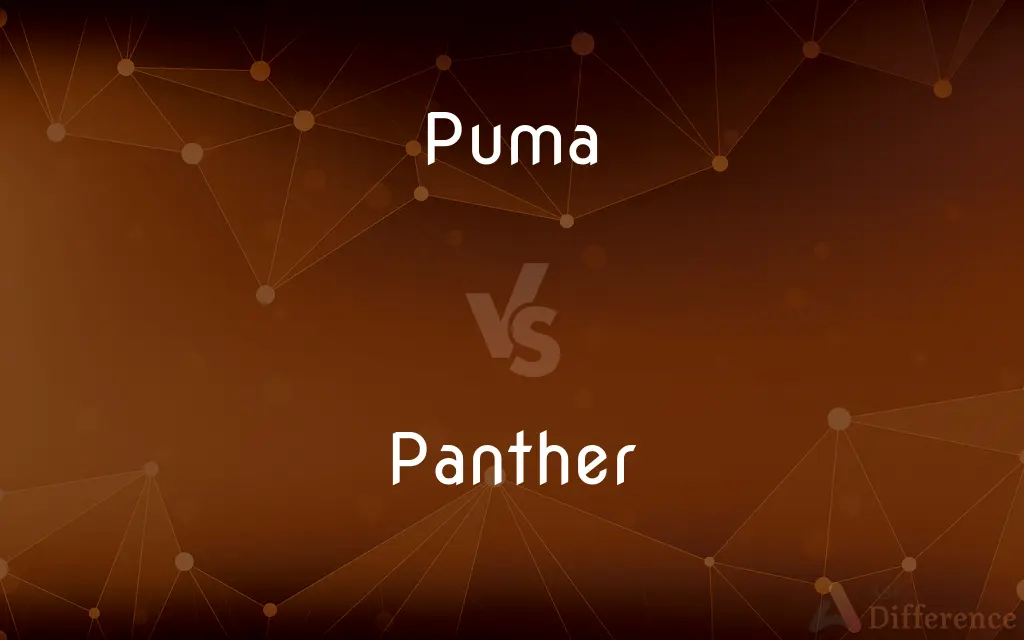Puma vs. Panther — What's the Difference?
Edited by Tayyaba Rehman — By Urooj Arif — Updated on April 15, 2024
Puma refers to a large wild cat native to the Americas, known for its agility and power, while panther generally describes a melanistic color variant of several big cat species.

Difference Between Puma and Panther
Table of Contents
ADVERTISEMENT
Key Differences
Pumas are known for their solitary nature, primarily found in the mountain ranges of North and South America. On the other hand, the term "panther" is used to describe melanistic big cats, which can be leopards in Asia and Africa or jaguars in the Americas, varying greatly in their geographical spread.
Pumas are recognized by their light brown coats and lack of spots, ideal for blending into their mountainous and forested habitats. Whereas panthers, being typically black, excel in camouflage during nighttime hunting.
In terms of behavior, pumas are known to roam large territories hunting deer and small animals. Panthers, depending on their actual species, may have varied diets and territorial habits.
Puma cubs are born blind and depend heavily on their mother for the first few months, showcasing the species' nurturing side. In contrast, panther cubs, whether they are jaguars or leopards, also share a similar dependency but their upbringing may occur in different environments such as rainforests or savannas.
Comparison Chart
Geographic Range
Americas, from Canada to South Chile
Worldwide, depends on specific species
ADVERTISEMENT
Base Species
Cougar
Leopards, Jaguars (when melanistic)
Coloration
Light brown, no spots
Typically black (melanistic)
Preferred Habitat
Mountains, forests
Varies (jungles, savannas, forests)
Hunting and Diet
Deer, small mammals
Species-dependent, generally larger variety
Compare with Definitions
Puma
Solitary by nature, except during mating or mothering.
The solitary puma roamed its territory alone.
Panther
Known for its black coat, aiding in camouflage at night.
The panther's black coat blended into the dark forest.
Puma
Notable for its large size and powerful build.
The puma's powerful build was evident as it sprinted.
Panther
Associated with leopards or jaguars depending on the location.
In Asia, a panther is typically a melanistic leopard.
Puma
Known scientifically as Puma concolor.
Puma concolor is an adept climber and jumper.
Panther
A term used to describe melanistic variants of big cats.
The panther moved silently through the shadows.
Puma
A large predator known for its strength and agile movements.
The puma leapt effortlessly over the log.
Panther
Occurs in a variety of habitats worldwide.
The panther has adapted to various environments from rainforests to grasslands.
Puma
Native to the American continent, often found in mountainous areas.
Hikers spotted a puma at the crest of the trail.
Panther
A large wild cat such as a leopard or jaguar, especially in a color form with black fur.
Puma
A German multinational corporation that designs and manufactures athletic and casual footwear, apparel and accessories
Panther
See cougar.
Puma
A large American wild cat with a plain tawny to greyish coat, found from Canada to Patagonia.
Panther
Any of various big cats with black fur; most especially, the black-coated leopard of India.
Puma
See cougar.
Panther
Any big cat of the genus Panthera.
Puma
A mountain lion or cougar (Puma concolor).
Panther
A cougar; especially the Florida panther.
Puma
(by extension) Any feline belonging to the genus Puma.
Panther
(slang) A girl, especially a young one, who pursues older men.
Paige is 16 and dates a 19 years old guy, she's such a panther.
Puma
(slang) A woman in her 20s or 30s who seeks relationships with younger men; a younger cougar.
Panther
A creature resembling a big cat with a multicolored hide, found in Ancient Greek mythology.
Puma
A large American carnivore (Felis concolor), found from Canada to Patagonia, especially among the mountains. Its color is tawny, or brownish yellow, without spots or stripes. Called also catamount, cougar, American lion, mountain lion, and panther or painter.
Panther
A large dark-colored variety of the leopard, by some Zoologists considered a distinct species. It is marked with large ringlike spots, the centers of which are darker than the color of the body.
Puma
Large American feline resembling a lion
Panther
In America, the name is applied to the puma, or cougar, and sometimes to the jaguar.
Panther
A large spotted feline of tropical America similar to the leopard; in some classifications considered a member of the genus Felis
Panther
A leopard in the black color phase
Panther
Large American feline resembling a lion
Common Curiosities
What do pumas eat?
Pumas primarily prey on deer, though they also hunt smaller mammals and birds.
What is a puma?
A puma is a large feline of the Cougar family, native to the Americas.
Are panthers a distinct species?
No, panthers are not a distinct species but rather refer to the melanistic color variants of leopards or jaguars.
How do panthers hunt?
Their hunting strategies vary depending on the base species; jaguar panthers might hunt in the water, while leopard panthers prefer stalking in dense vegetation.
Are pumas endangered?
Pumas are considered of least concern, but local populations may be at risk due to habitat loss and conflicts with humans.
Can pumas be found in cold climates?
Yes, pumas can adapt to a range of climates, including colder mountainous regions.
What does "panther" refer to?
Panther is a general term for melanistic (black) variants of several species of large cats, including leopards and jaguars.
Where do pumas live?
Pumas inhabit a variety of environments across North and South America, from mountains to forests.
What is the lifespan of a panther?
Depending on the species and environment, panthers typically live 12-17 years in the wild.
What symbol does panther represents?
They represents power and stealth in many cultures. The panther is often a symbol of strength and mystique in folklore.
Share Your Discovery

Previous Comparison
So vs. Then
Next Comparison
Turnover vs. IncomeAuthor Spotlight
Written by
Urooj ArifUrooj is a skilled content writer at Ask Difference, known for her exceptional ability to simplify complex topics into engaging and informative content. With a passion for research and a flair for clear, concise writing, she consistently delivers articles that resonate with our diverse audience.
Edited by
Tayyaba RehmanTayyaba Rehman is a distinguished writer, currently serving as a primary contributor to askdifference.com. As a researcher in semantics and etymology, Tayyaba's passion for the complexity of languages and their distinctions has found a perfect home on the platform. Tayyaba delves into the intricacies of language, distinguishing between commonly confused words and phrases, thereby providing clarity for readers worldwide.














































